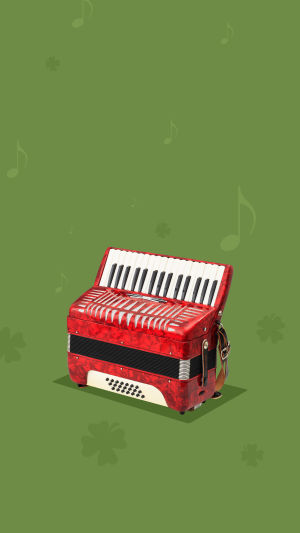The accordion is a keyboard instrument that can be played both solo and with accompaniment. It can play both beautiful melody of single part and multi-part music, and can play rich harmony with both hands, just like a piano.
The accordion has a great timbre, rich timbre changes, and the ingenious combination of fingers and bellows can play a variety of different styles of music, which is unmatched by many musical instruments.
In addition to independent performances, you can also participate in duets and ensembles, it can be said that the accordion is a small band.
Techniques for playing the accordion.
1. Posture.
Playing posture is natural, relaxed, and positive posture is a good foundation for playing.
The accordion is usually played in a seated position. When playing, the upper body is naturally upright, the feet are separated, about shoulder width, and the soles of the feet are on the ground.
During the performance, the center of gravity should be stable, and the center of gravity should not be moved with the push and pull of the bellows.
The shoulder straps on the body should be adjusted well, neither too loose nor too tight. Usually the right shoulder strap is slightly wider than the left shoulder strap so that the hands are not tied. The bottom is basically placed on the leg, and the lower end of the keyboard on the right is slightly lower, close to the leg.
The 2nd, 3rd, 4th, and 5th fingers of the corrugated band of the left hand are naturally bent, leaning against the button, and the thumb is relaxed.
The bellows strap fits snugly on the back of the wrist, take care to adjust the bellows strap to tighten. The right hand is naturally raised, the five fingers are naturally bent and placed on the keyboard, and the wrist is parallel to the keyboard, neither convex nor concave.
2. Basic touch key method.
The legato touch of the accordion is based on the accurate relaxation of each part of the body, emphasizing the continuity and continuity of the finger touch action, that is, pressing first and then lifting.
Only through the movement of the metacarpophalangeal joints, forming a "pressing" touch, can the true coherence of the sound be effectively achieved.
Because it takes time for a finger to touch a button from start to finish, even if the process is only a fraction of a second.
When the previous note played by one finger stops, it is time for the other finger to play the next note, which requires the latter finger to touch the previous key before the finger on the key leaves the key.
In addition, the lower keys of the left hand of the accordion sink deeper than the keys of the right hand, and the tone is slightly monotonous.
Therefore, when realizing the continuous shooting of the left-hand low-key keys, the time difference for the latter finger to touch the keys in advance should be more obvious than that of the right-hand high-pitched keyboard.
The benefits of learning the accordion.
1. Regular practice can improve hand and body coordination.
Accordion performance requires the participation of both hands at the same time. When playing the piano, the fingertips are constantly in contact with the keyboard and keys at different speeds and at different times, which increases the chance of information transmission between nerve endings and nerve endings.
The control of the finger muscles is also improved accordingly. Over time, the information processing ability of the left and right brains will be greatly enhanced, the reaction ability will be improved, and the fingers will be more flexible.
2. Improve concentration.
Play while reading and playing, and attention will be improved accordingly, attention will be improved, and memory will be improved.
Are you interested in the accordion?





